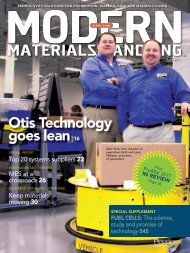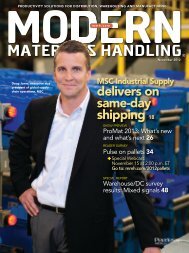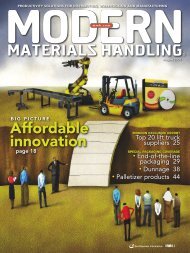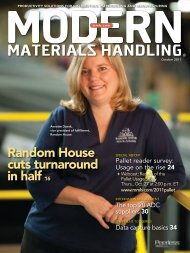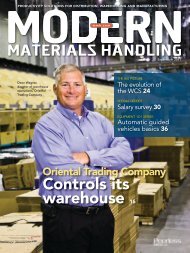You also want an ePaper? Increase the reach of your titles
YUMPU automatically turns print PDFs into web optimized ePapers that Google loves.
planning (ERP) system serves the same purpose. It is a packaged<br />
business software system that allows a company to:<br />
• Automate and integrate the majority of the business<br />
processes,<br />
• Share common data and practices across the entire enterprise,<br />
and<br />
• Produce and access information in a real-time environment.<br />
ERP systems reside at the host or corporate level. Think<br />
of them as the wiring and plumbing of a company: Typically,<br />
the core business processes managed by the ERP involve<br />
the manufacturing, distribution and financial needs of a<br />
company, including cost accounting, inventory, purchasing,<br />
customer orders, invoicing, vendor invoices and payments,<br />
customer receipt processing, general ledger and shop floor<br />
control features.<br />
The data created by those processes is maintained in a<br />
common file and in a common language understood by all<br />
the other systems in an enterprise, whether those systems<br />
are part of an integrated supply chain suite or linked together<br />
through interfaces.<br />
Order management<br />
Filling an order begins with an order management system<br />
(OMS). These systems capture order information from customers<br />
by phone, fax, EDI (electronic data interchange) or<br />
the Web. OMS systems were once a function of an ERP system:<br />
They checked credit, passed an order on to a supply<br />
chain execution system, and tracked the status of an order in<br />
batch mode. A company with multiple divisions—and multiple<br />
ERP systems—might have multiple order management<br />
systems.<br />
Contemporary systems, also known as multi-enterprise<br />
OMS, sit above the ERP and present one face to the customer:<br />
Place an order and the OMS will parse out the different<br />
line items of an order to the right division, the right<br />
manufacturing plant, the right third-party distributor or the<br />
right warehouse. The OMS then passes that information on<br />
to the other systems and partners in the supply chain to fill<br />
the order.<br />
SUPPLY CHAIN PLANNING<br />
Supply chain planning<br />
Supply chain planning (SCP) software is an umbrella technology<br />
that enables you to do advanced supply chain planning<br />
and scheduling including decision support, optimization<br />
and cross-functional decision making.<br />
An SCP system usually resides at a corporate level, where<br />
it looks at the orders to be manufactured, picked and shipped<br />
as well as the constraints, or limitations, on the availability of<br />
capacity, materials, equipment and human resources. With<br />
that information, the system determines the best way to<br />
Manufacturing execution systems (MES) synchronize<br />
manufacturing processes across a facility or supply chain.<br />
schedule an order and plan for the future. Planning software<br />
may even determine that an order can’t be profitably filled<br />
under any circumstances and shouldn’t be scheduled. While<br />
there are many planning components, most attack a problem<br />
from one of three angles:<br />
• Strategic planning looks at capital asset allocation as well<br />
as market and sourcing decisions, like where to locate a<br />
warehouse or DC to serve a particular market.<br />
• Tactical planning asks the questions: Given my customers’<br />
demand and my resources, what can I make that will<br />
produce the most profit for my company?<br />
• Operational planning takes the supply chain plan developed<br />
by the strategic and tactical planning programs and<br />
develops an operational path to execute those plans.<br />
First, it may develop weekly production and stocking<br />
schedules. Then, it might break the weekly plans into<br />
smaller units of time, right down to the day, hour, minute<br />
and even second.<br />
Multi-echelon planning<br />
This is an emerging application used to optimize the amount<br />
and positioning of inventory across the supply chain.<br />
Traditional inventory optimization is a little like playing<br />
checkers: These systems look at inventory in one dimension,<br />
such the inventory levels at a specific warehouse or<br />
parts depot.<br />
A multi-echelon solution is like playing Chinese checkers:<br />
It looks beyond the inventory levels at a single location<br />
and optimizes inventory positions in the equivalent of three<br />
mmh.com MODERN MATERIALS HANDLING / A PRIL <strong>20</strong>09 27




